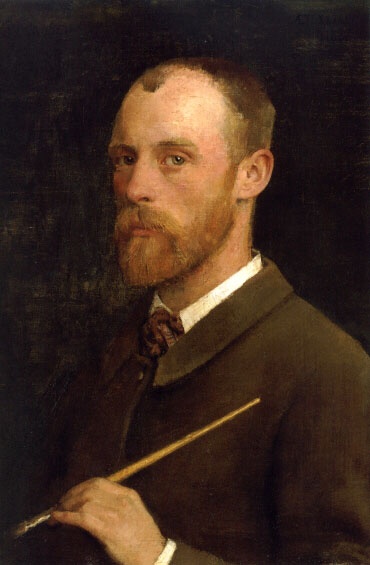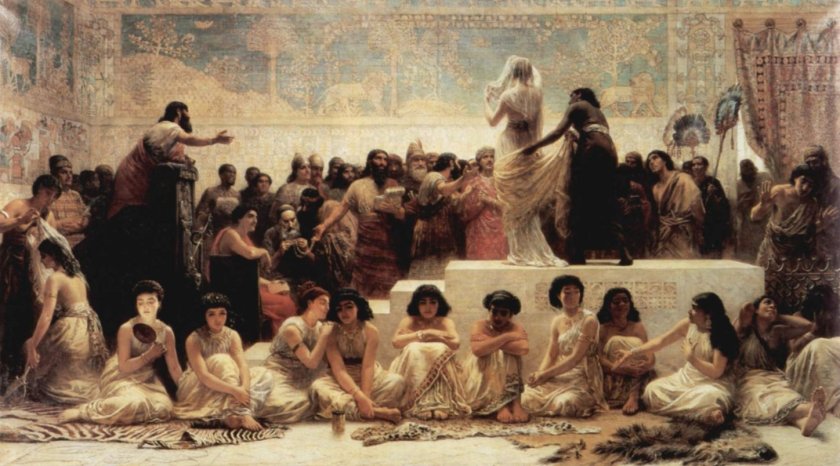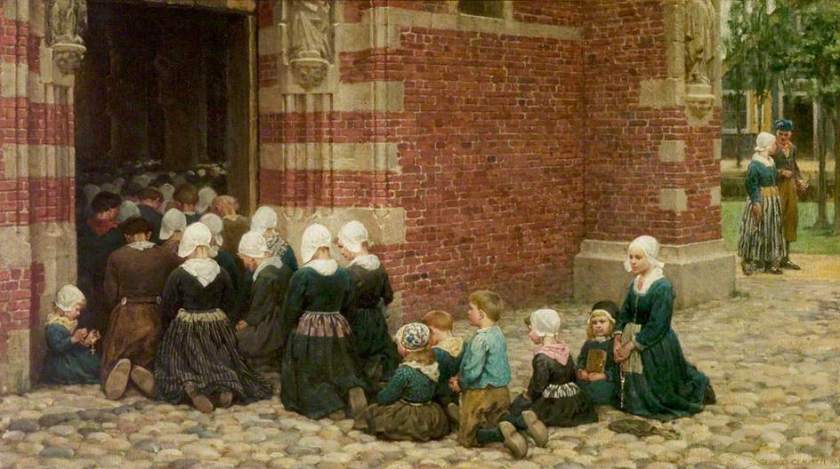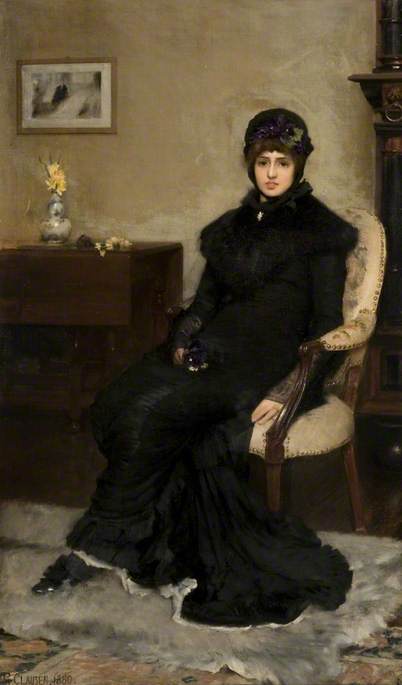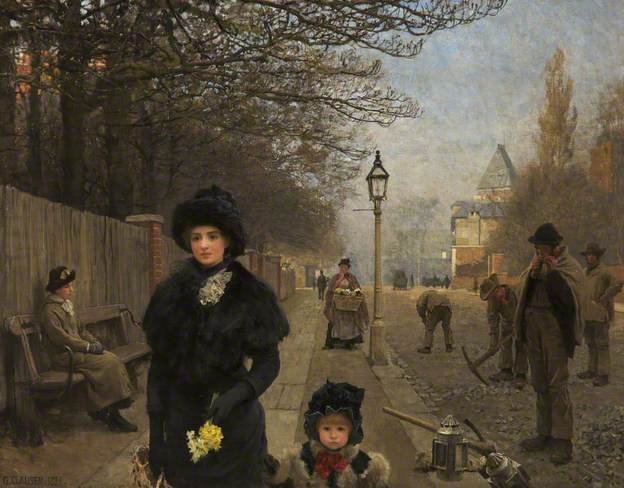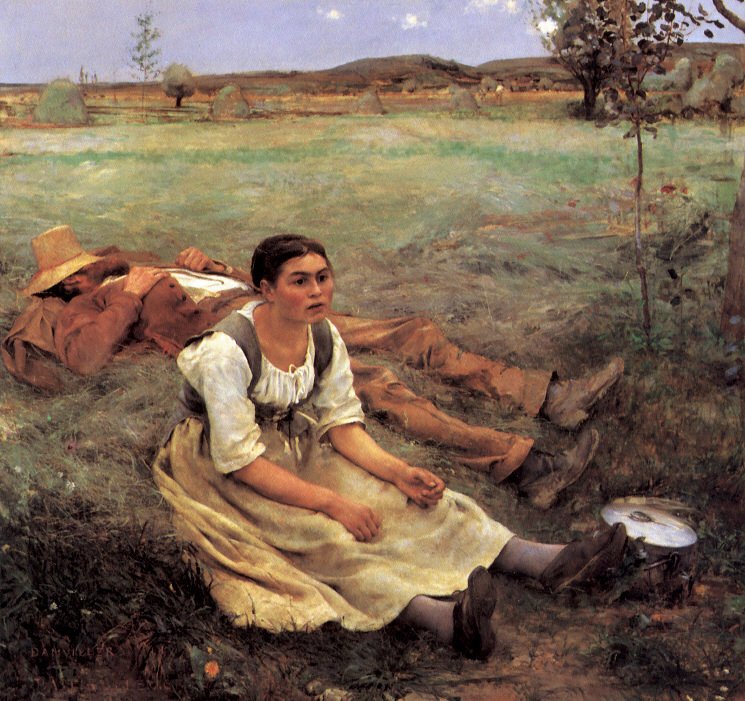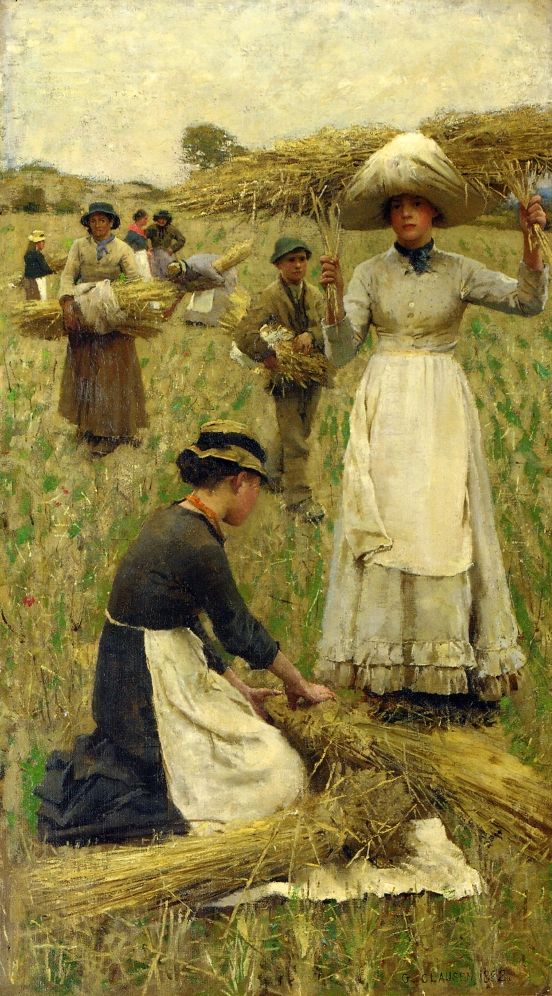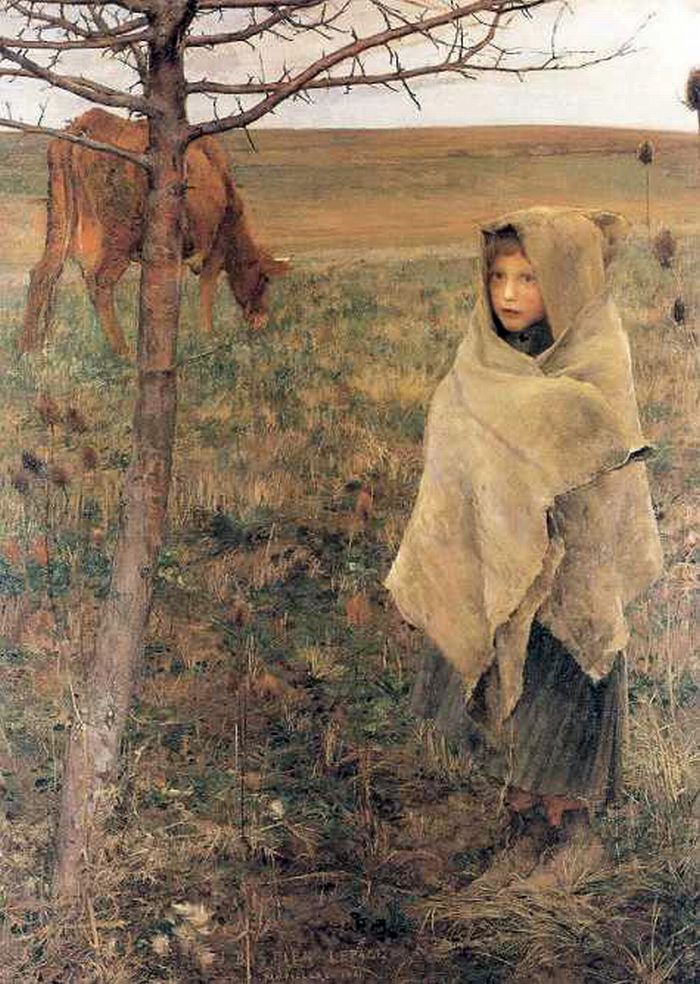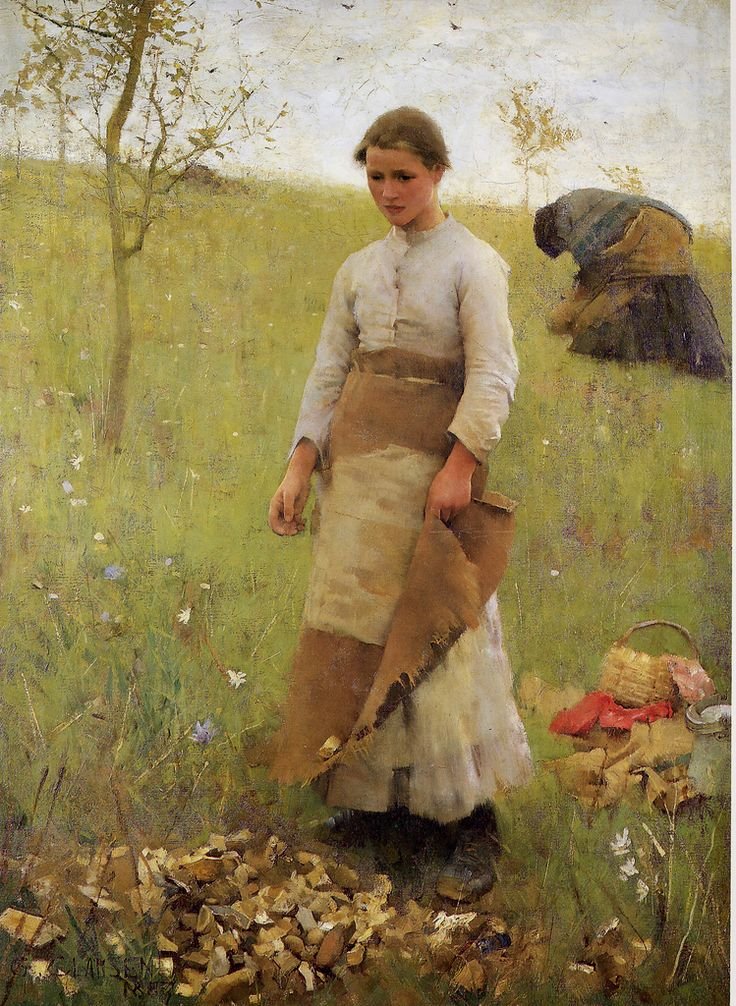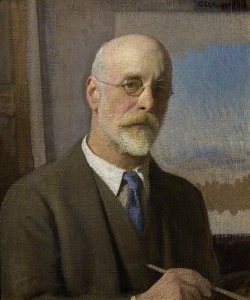
1852 – 1944
In this concluding part looking at the life and works of George Clausen, later Sir George Clausen, I will focus on his love of depicting workers labouring in the fields in a genre of art which was often referred to as rustic naturalism and have a look at a couple of works he completed whilst he was employed as a war artist.

In 1881 George Clausen married Agnes Mary Webster of Kings Lynn and they went on to have three sons and a daughter. Clausen had met her brother, Alfred, at South Kensington Art School where he was also studying art. The following year Clausen painted his wife’s portrait.
Henry La Thangue, an English landscape painter, who had visited Brittany to paint and was a friend of Stanhope Forbes, another landscape artist, persuaded Clausen to take a trip there to discover the countryside and light the French area had to offer. And so, in 1882, Clausen sett off for Brittany with his wife and visited the artist colony at Quimperlé, a small town, fifteen kilometres east of the other popular haven for artist, Pont Aven. Here they met up with the Dublin-born artist, Stanhope Forbes who, two years later, moved to Newlyn in Cornwall and became a leading figure in that growing colony of artists. Stanhope Forbes was excited that Clausen was to join him at Quimperlé writing to his mother in September 1882:
“…Thangue tells me he is sending G.Clausen the painter and his wife. Very glad as he is a really good painter in fact belongs to the sacred band whom even I admire…”
It was whilst here that Clausen produced a number of wonderful paintings depicting local peasant farm workers and their families.
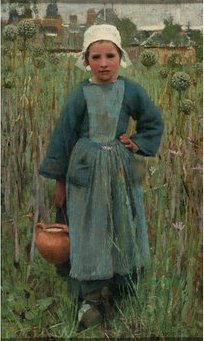
One such work was entitled Peasant Girl Carrying a Jar, Quimperlé which he completed in 1882. This is a portrait of a young girl seen standing in a field, hand on hip, holding an earthenware pot. She is dressed in a peasant costume, the quality of which indicates that she is from a family of limited means. She is surrounded by tall spherical flowering onion plants. It is interesting to look closely at the way Clausen has depicted the pose of the young girl. This is not the pose of a professional model. This is a peasant girl displaying the uncomfortable pose of a young child, which makes the image of her appear so realistic. There is no harshness about the way Clausen has depicted her facial expression. It is a face that exudes gentleness. What must be going through the child’s mind as she poses for this foreigner, the artist?
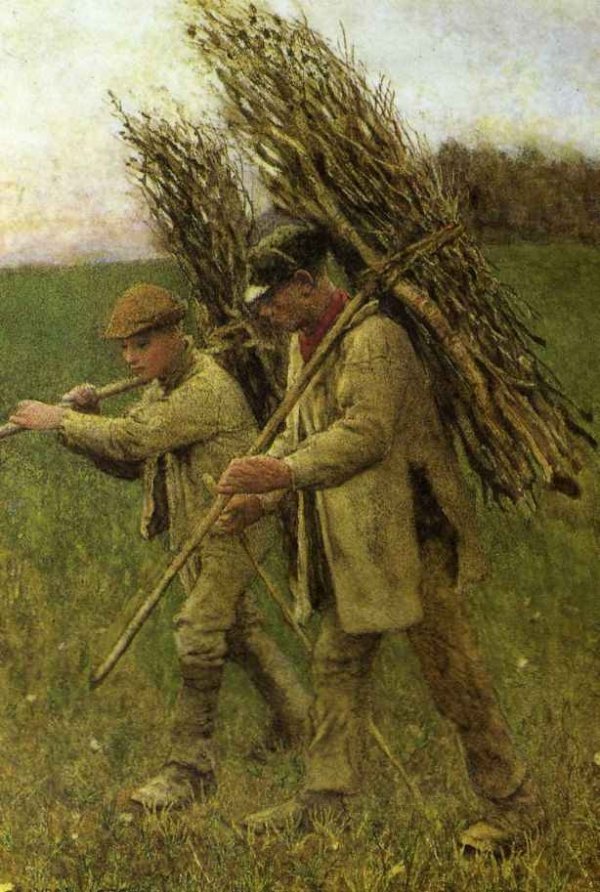
The next featured work of Clausen is a small watercolour (35 x 26 cms) which he again completed in 1882. The painting, entitled The Return from the Fields depicts two young workers carrying bundles of brushwood which had been obtained by thinning out the copses. This brushwood was used for hedging, or as beating implements used for fire fighting or sometimes used to construct sheep hurdles. That year, the painting was exhibited at Institute of Painters in Watercolours, in London, under the title of Boy and Man and the art reviewer of the Magazine of Art commented favourably on the work:
“… the most artistic work on the walls……a small drawing, but it is so strong, and at the same time so tender and full of feeling, that it arrests attention more powerfully than the other pictures together. It is evidently inspired by Millet…….he has struck the right road…”
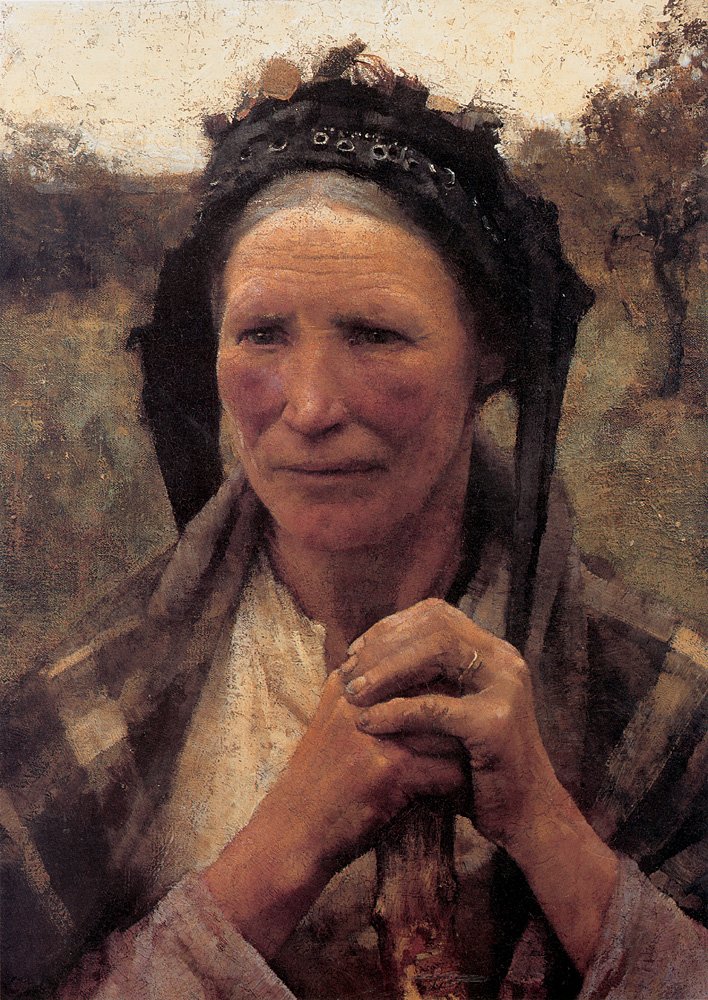
Clausen painted two close-up portraits of peasant labourers. The first was entitled Head of a Peasant Woman which he completed in 1882. This is a wonderful portrait. It is a triumph of realism as Clausen has depicted the woman, “warts and all”. We see her weather beaten face caused by the many days and weeks of working the fields and her wrinkled bow is testament that she has endured a hard and worrisome life. She doesn’t look directly at us as she rests her hands on a long stick. The ring on her wedding finger glints in the sunlight.

The second portrait was an oil and canvas study of a young boy who was to figure in a work entitled Labourers after Dinner. This painting is held in a private collection in Australia and I have not been able to find a colour copy of it so have just scanned a black and white version which I found in a magazine. The painting was the first indication that Clausen was moving away from the emotional depiction of peasant pictures which had been popularised in England and France by Jules Bastien-Lepage. Clausen veered towards more naturalistic, if brutal, genre subjects. This work was one of the most studied of Clausen’s early compositions. It is a depiction of a boy sitting between his mother and father who were taking a rest from their work in the fields. The controversial Irish novelist and art critic, George Moore, on seeing the painting, wrote scathingly about the group depicted in the painting in his 1893 book entitled Modern Painting. In it he commented on the depiction of the boy’s mother and father:
“…the middle aged man and woman who live in mute stupidity – they have known nothing but the daily hardship of living and the vacuous face of their son tells how completely the life of his forefathers has descended upon him…”
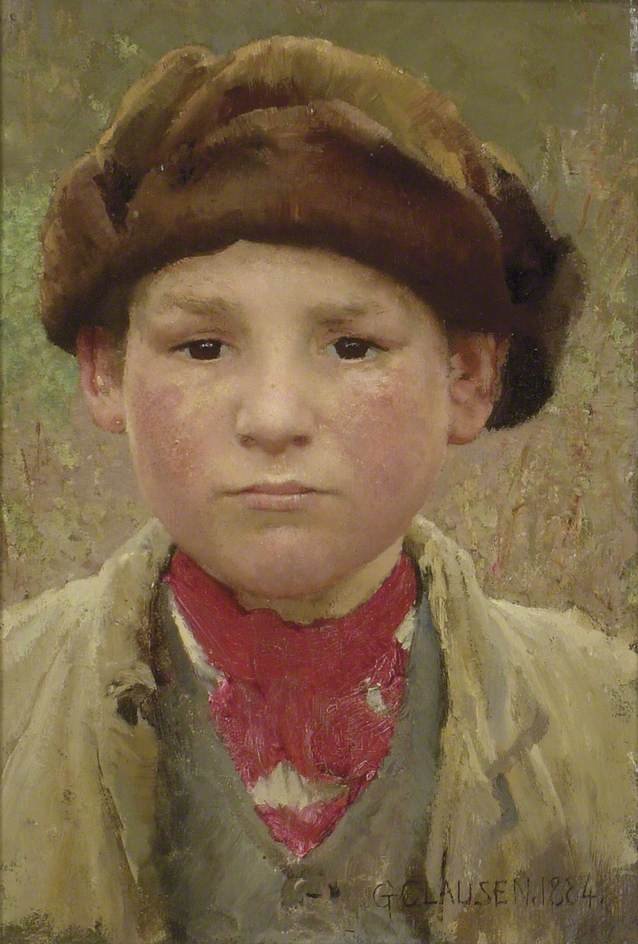
A “vacuous face” wrote Moore. I will let you decide as the oil sketch Clausen made prior to the large scale painting, entitled Head of a Peasant Boy is awash with detail. George Moore was not a lover of realism in art as in the same book he condemned it saying:
“…Realism, that is to say the desire to compete with nature, to be nature, is the disease from which art has suffered most in the last twenty years. The disease is now at wane, and when we happen upon a canvas of the period like Labourers after Dinner, we cry out, ‘What madness! Were we ever as mad as that?”…”
Harsh words indeed and yet I like this painting.

Clausen was a founder member of the New English Art Club (NEAC) of London which was set up in 1885 in competition with the Royal Academy. It was a club which attracted many young inspiring artists who were returning to England after their artistic studies in Paris. One of Clausen’s first paintings to be exhibited at an NEAC exhibition was The Shepherdess which he completed in the Spring of 1885 and which is now art of the National Museums, Liverpool collection. Clausen had sold the painting to John Maddocks an artist and art collector, and borrowed it back to show at the exhibition. The orchard in which the young girl stands was to feature in a number of Clausen’s works. In 1891, the art critic of The Magazine of Art, Butler Wood, commented on the work:
“…admirable specimen of Mr Clausen’s best manner, and displays feeling and atmosphere. His colour scheme is simple, yet satisfactory and skilfully elaborated. The girl’s figure is modelled with almost sculpturesque strength and the face painted with that ruddy glow of health which he is so clever at rendering…”
In 1891 Clausen moved from the Berkshire village of Cookham Dean and went to live in Widdington, a small picturesque village in the county of Essex. He had been exhibiting most of his works at the New Gallery and the NEAC but as his paintings became larger in size they were not easily accommodated at these venues and so he had to once again look at exhibiting his larger works at the Royal Academy in London. Clausen had fallen out with the Royal Academy years earlier over their teaching methods and their strict and antiquated rules but now, with an ever expanding family, he needed the support of the Academy if he was to sell his larger works. In 1895, Clausen was elected an Associate of the Royal Academy. The art world noted his election to an establishment he had once roundly criticised but many saw Clausen as an excellent addition to the RA. The scholar and prolific art critic of the time, often referred to as “one of the most powerful figures in the late Victorian art world”, Marion Spielmann, wrote about Clausen’s appointment in the February 1895 edition of weekly illustrated newspaper, The Graphic:
“…Mr Clausen was…… a signatory of the open letter which years ago set fire to the inflammable material which we young hot-bloods had….pile up against the door of the Academy…. much amelioration has been brought since then; the girls may now study from the semi-nude; then standard of probationership has been raised….”
Clausen now worked within the Academy system, a system which he had once heavily criticised. He gave up his time, a couple of months each year, to teach students at the Royal Academy Life School Between 1904 and 1906 and in that year he became Professor of Painting at the Academy and, because of the large number of students who attended his lectures, was regarded as one of the most popular professors since Joshua Reynolds.

One of the works Clausen completed in 1896 was entitled Bird Scaring: March, and which is housed in the Harris Museum and Art Gallery, Preston. In Victorian days bird scarers were employed by farmers to act as human scarecrows. Their task was simple; they just had to position themselves in the farmer’s field and scare off the birds which swoop down to eat the farmer’s crops. This onerous job was for very young children who had to be working in the fields, dawn to dusk, no matter what the weather was like. In the painting we can see the young boy who, despite the cold weather, wears only sack-cloth. A small fire has been lit on the ground to keep him warm. The blue/grey smoke from the fire wafts behind him giving us the sense that it is not only cold but also windy. He is energetically swinging around, holding a wooden clapper in his right hand which made sufficient noise to deter birds from landing nearby.
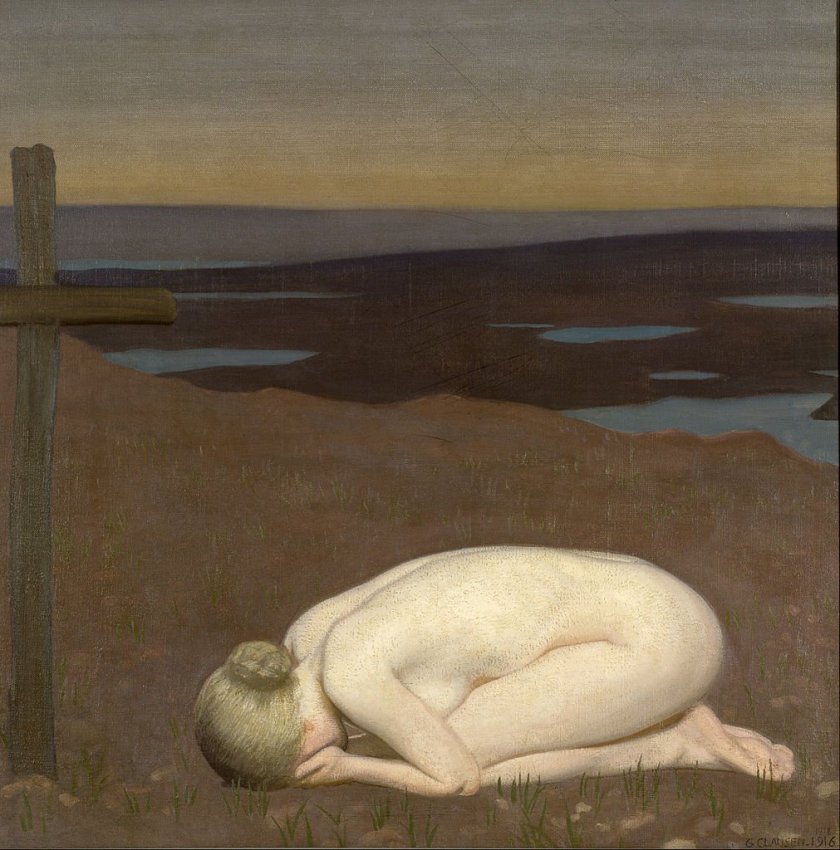
For my next two featured works by Clausen you will notice a complete change of style. The first one was completed in 1916 and entitled Youth Mourning. The work you see is not the original version but one altered on the request of the purchaser. Clausen, who was sixty-four when he painted this work was too old for military service in the First World War, however he was not untouched by the many tragedies of the Great War for his son-in-law, the husband of his daughter Kitty, was killed in battle in 1915 and it was that sad event which moved him to paint this work. It was his personal expression of grief for the thousands who perished during the conflict. This was an artistic departure of his favoured rustic naturalism style and more towards the French Symbolist genre.
In the original work there were three white crosses in the ground just behind the female and further in the background many more white crosses could be seen. When the owner of the work, a Mr C.N.Luxmoore, who bought this and many other paintings from Clausen presented it to the Nation in 1929 the crosses had been painted out just leaving a barren shell-holed hillside. We have no definitive reason why the owner got Clausen to re-paint part of the work. The resulting work has a powerful symbolic aura of anguish and sorrow captured by the nude female figure hunched over in the foetal position. The finality of death is depicted by the barrenness of the landscape where nothing lives.
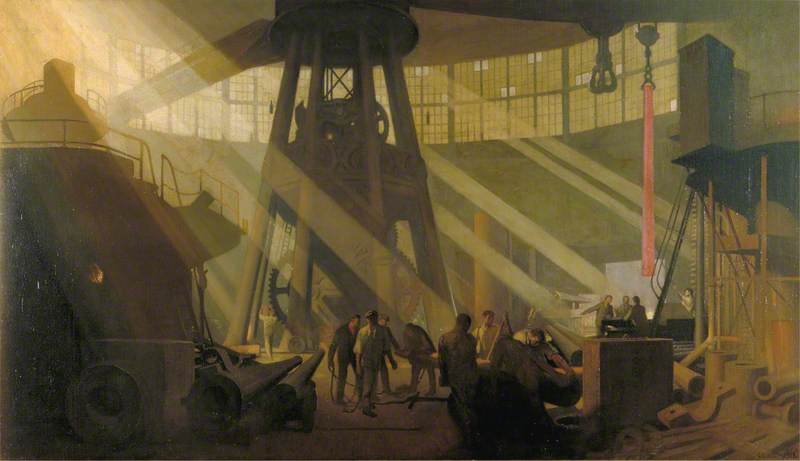
George Clausen was later appointed an official war artist and took part in the ambitious British War Memorials Committee art scheme in 1918. He produced a large 183 x 318cms oil on canvas work in 1918 entitled In the Gun Factory at Woolwich Arsenal, 1918. This urban scene once again is huge shift away from rustic idylls of the countryside we saw in his earlier works. The painting was a commission Clausen received from The Ministry of Information who said they wanted a “Uccello” sized work of art which would be exhibited in the Hall of Remembrance. Clausen visited the gun factory on a number of occasions and had originally intended that the painting would be in an upright format but eventually realised that it had to be of a horizontal format. The work was finally completed in December 1918 and was first exhibited at the Royal Academy Winter Exhibition of 1919-20. Critics believed it was one of the best works on display. In 1926, due to his successful war commission he was commissioned to paint murals, notably Wycliffe’s English Bible for the Houses of Parliament and on completion of this task he was knighted. He continued to regularly exhibit work at the Royal Academy during the 1930’s.

One of last paintings by Sir George Clausen was one he completed in 1940 entitled My Back Garden. It was a depiction of the back garden of his house at 61 Carlton Hill, London. He was eighty-eight years of age when he painted this picture. It was almost a farewell painting as a year later; he had left his beloved house and garden because of the almost continuous bombing of London by the Nazis. He decided that he and his wife should move to Cold Ash, a Berkshire village some two miles from the town of Newbury and seventy miles west of London. Clausen continued to sketch and complete watercolours which he sent off for inclusion in the Royal Academy Summer Exhibitions of 1942 and 1943. Clausen’s wife’s health had deteriorated in 1939 and she remained poorly until her death in March 1944. Sir George Clausen died eight months later in November 1944, aged 92. In June 1944, just five months before Clausen’s death, he was approached by Kenneth Clark, the Director of the National Gallery, proposing a retrospective exhibition of his work at the National Gallery. Clausen was delighted with the proposal and wrote back to Clark:
“… I think such an exhibition as you suggest would be more appropriate when I am dead and indifferent to praise or censure ! However I will help you all I can…”
Sadly the exhibition never took place.

